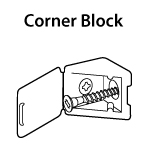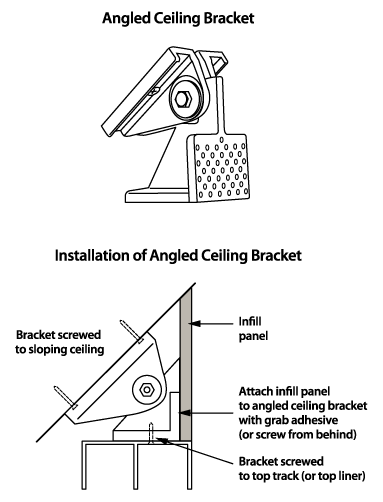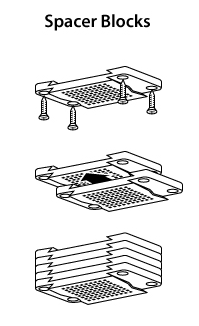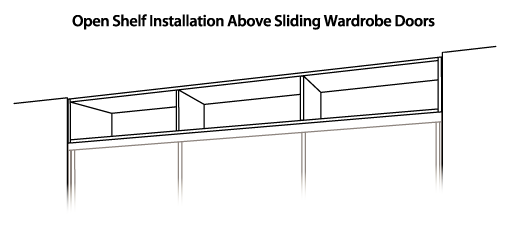REQUIRE A BESPOKE LOOK?
We offer a custom design
service at NO extra cost.
Problem: You want built-in sliding wardrobe doors but your ceiling height is higher than our standard 2480mm height doors.
Solution: Fit an infill panel (with or without height reducers, angled ceiling brackets or spacer blocks) to give a professional floor to ceiling finish with no gap.
Alternative solutions: Create an open shelving installation or purchase our tall sliding wardrobe doors
Note: We can make bespoke wardrobe doors up to 2750mm - please freephone 0800 035 1730 for a quote.
If you wish to achieve a ‘floor-to-ceiling’ wardrobe installation where the room height is taller than the wardrobe then the gap or void above the top sliding door track up to the ceiling will need to be
filled. The panel used for this purpose is called an infill panel.
Using Melamine faced board (MFC) as an infill panel
You could use the same material as your doors (except glass or mirrored glass) to achieve a co-ordinated look to your final installation, but also consider an infill panel that is neutral in colour or a colour to complement your room.
MFC infill panels are available from us in two standard sizes and a variety of colours.
The standard sizes available are:
18mm x 100mm x 2620mm; and
18mm x 500mm x 2620mm
These can be cut down to the exact height and width required. If your aperture width is greater than 2620mm it is possible to butt two MFC infill panels together and cover the joint with a plastic cover strip (not supplied).
Using plasterboard and skim as an infill panel
Plasterboard may also be used to fill the gap and this can then be skimmed with plaster to create a seamless finish with the walls on either side of the opening aperture. Although this may involve the services of a professional plasterer the overall finish will offer the most effective built-in look when painted or wallpapered.
With the material for your infill panel chosen you can now consider which will be the most practical method to fix it within your wardrobe installation.

If you have already created a floor to ceiling timber batten framework for your wardrobe installation (incorporating top and bottom liners and strike plates) the simplest method for fitting an MFC infill panel is to use plastic corner blocks. These are widely available at most DIY stores.
Method:
Measure the dimensions (width x height) of the void to be filled and cut the infill panel to size. It's a good idea to use masking tape to protect the laminate surface of the MFC panel whilst cutting.
Position the infill panel in place against the timber battening framework and then, from the inside of the wardrobe space, mark a line around the back of the panel along all four edges where it meets the timber framework.
Remove the infill panel and at each corner (and spaced evenly along the top and bottom edges) screw plastic corner blocks, with their right-angled edges flush with the lines you have marked on the back of the panel.
With the infill panel held back firmly in its final position, screw through the holes of the corner blocks into the timber batten framework and top liner on all four sides.
If using plasterboard as an infill panel over a timber batten framework it is possible to fix the plasterboard directly to the batten edges using a grab adhesive.
Depending upon the overall aperture width to be infilled it is advisable to provide vertical support battens at approx. 500mm centres to act as extra bracing when using a plasterboard infill panel.

Height reducers are available in larger DIY outlets and consist of a plastic stem and two end fixings which can be used for gaps between 130mm and 460mm. A number of different manufacturers offer these.
Method:
The manufacturer’s instructions should always be consulted but the basic fixing method is as follows:
Screw the top bracket in position on the ceiling.
Cut the plastic stem of the height reducer to match the height to be filled and then attach the bottom fixing.
The bottom fixing can be screwed into the top liner or directly into the top track of the sliding doors.
Repeat this process with the second height reducer and attach to the other side of the aperture.
If using MFC cut the infill panel to size and screw in place from the rear, through the lugs on the fixings.
If using plasterboard as an infill panel use a grab adhesive to fix the panel to the front edges of the height reducers.
Depending upon the overall aperture width to be infilled it is advisable to provide additional height reducers at approx. 500mm centres to act as extra bracing when using a plasterboard infill panel.
Because the end fixings of the height reducers are designed to pivot on the stem they are well-suited to use on sloping ceilings when building and installing sloping eaves wardrobes as they can be angled, thus allowing the infill panel to be fitted vertically.

Angled ceiling brackets are designed specifically for use when installing sliding wardrobe doors in eaves situations. They consist of two pivoting brackets that are connected together with an adjustable bolt. One half of the bracket has a large, flat area on the front face to allow an infill panel to be fixed. Angled ceiling brackets are ideal for use in situations where there is limited space or when the infill panel height is typically less than 130mm. Once the ceiling half of the bracket has been fixed the other half can be fixed either directly to the top track, or the top liner, by screwing - see diagram. It is recommended that angled ceiling brackets are spaced evenly across the width of your sliding wardrobe installation at 50cm intervals.

These tough plastic interlocking blocks are typically available in packs of 12 units and are designed for filling gaps between 15mm and 114mm.
Successive blocks can be added to create increments of 24, 33, 42, 51, 60, 69, 78, 87, 96, 105 and 114mm.
The number of packs required will vary depending upon the depth of the gap to be filled and the overall width of the aperture.
Method:
The basic installation method is to layer the blocks until the desired depth is achieved.
After drilling and plugging, screw the first spacer block to the ceiling using suitable fixings.
Add additional spacer blocks by sliding in to the shaped channel of the previous one until the gap between the ceiling and the top liner (or the top track) is filled.
The bottom of the stack can be secured by screwing through the underside of the top liner or through the underside of the top track.
Repeat this process across the width of the aperture, spacing the individual stacks of blocks at equal distances to provide adequate support points for the infill panel to be fixed to.
If using MFC cut the infill panel to size and either screw it to the spacer blocks from the front face (using plastic cover caps to disguise the heads of the screws); or use a grab adhesive applied to the sides of the spacer blocks to fix it in place.
If using plasterboard as an infill panel use a grab adhesive to fix the panel to the sides of the spacer blocks.
Depending upon the overall aperture width to be infilled it is advisable to provide additional stacks of spacer blocks at approx. 500mm centres to act as extra bracing when using a plasterboard infill panel.
To order an infill panel from us check the colour and material you require here and call freephone 0800 035 1730.
In certain instances it may not be possible or preferable to ‘box-in’ the top of the wardrobe up to the ceiling - for example if you have extremely high ceilings or you have ornate period cornicing which you don't want to cover up.
Instead of creating an infill panel you may consider simply adding a top panel to your wardrobe installation.
If there is sufficient space between the top of the wardrobe and the ceiling then this can also be used for the storage of items such as hat boxes, decorative storage boxes etc.
Please refer to the installation guide for details on how to create a top panel for your wardrobe.
Another option is to create an open shelf installation across the width of the top of your sliding wardrobe, with vertical dividers placed at intervals to suit your own design. This can be built directly off the top panel of your wardrobe by using a top liner attached to the ceiling with grab adhesive and additional sections of top liner cut down to create the dividing panels. The sections can be fixed together using plastic corner blocks and screws - see illustration.

To achieve a floor-to-ceiling installation without using an infill panel please see our article tall sliding wardrobe doors. and order by calling freephone 0800 035 1730.
For standard height doors begin by creating your design.
We hope you found this article useful. If you would like to discuss your project with our Design Team please ring freephone 0800 035 1730.

We offer a custom design
service at NO extra cost.
Follow these simple guidelines to
get the perfect fit for your sliding
wardrobe doors.
The sliding wardrobe doors are
very easy to install so you don’t
have to be a DIY expert.
Request FREE samples to help
with the design process and
colour matching.